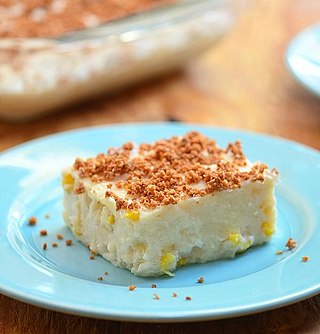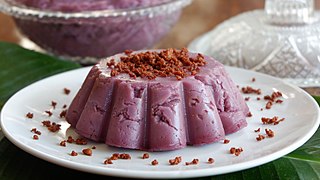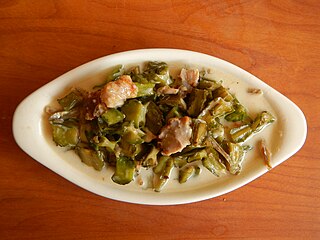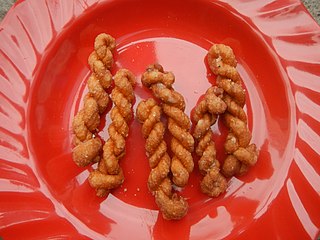
In cuisine, an omelette is a dish made from eggs, fried with butter or oil in a frying pan. It is quite common for the omelette to be folded around fillings such as chives, vegetables, mushrooms, meat, cheese, onions or some combination of the above. Whole eggs or egg whites are often beaten with a small amount of milk, cream, or water.

Scrambled eggs is a dish made from eggs stirred, whipped, or beaten together typically with salt, butter, oil, and sometimes other ingredients, and heated so that they form into curds.

Calabaza is the generic name in the Spanish language for any type of winter squash. Within an English-language context it specifically refers to what is also known as the West Indian pumpkin, a winter squash typically grown in the West Indies, tropical America, and the Philippines. Calabaza is the common name for Cucurbita moschata in Cuba, Florida, Puerto Rico, and the Philippines. C. moschata is also known as auyama in Colombia, the Dominican Republic and Venezuela; ayote in Mexico and Central America; zapallo in certain countries of South America; and "pumpkin", "squash", or "calabash" in English-speaking islands.

Torta is a culinary term that can, depending on the cuisine, refer to cakes, pies, flatbreads, sandwiches, or omelettes.

Maja blanca is a Filipino dessert with a gelatin-like consistency made primarily from coconut milk. Also known as coconut pudding, it is usually served during fiestas and during the holidays, especially Christmas.

Ube halaya or halayang ube is a Philippine dessert made from boiled and mashed purple yam. Ube halaya is the main base in ube/purple yam flavored-pastries and ube ice cream. It can also be incorporated in other desserts such as halo-halo. It is also commonly anglicized as ube jam, or called by its original native name, nilupak na ube.

Gising-gising, also known as ginataang sigarilyas, is a spicy Filipino vegetable soup or stew originating from the provinces of Nueva Ecija and Pampanga in the Philippines. It is traditionally made with chopped winged beans, and coconut milk spiced with labuyo chili, garlic, onions, and bagoong alamang. The name literally means "wake up, wake up". It can be eaten alone, on top of rice, or as a side dish to grilled meat dishes. It is a type of ginataan.

Tortang talong, also known as eggplant omelette, is an omelette or fritter from Filipino cuisine made by pan-frying grilled whole eggplants dipped in an egg mixture. It is a popular breakfast and lunch meal in the Philippines. A common variant of tortang talong is rellenong talong, which is stuffed with meat, seafood, and/or vegetables.

Okoy or ukoy, are Filipino crispy deep-fried fritters made with glutinous rice batter, unshelled small shrimp, and various vegetables, including calabaza, sweet potato, cassava, mung bean sprouts, scallions and julienned carrots, onions, and green papaya. They are traditionally served with vinegar-based dipping sauces. They are eaten on their own or with white rice. They are popular for breakfast, snacks, or appetizers. Okoy are sometimes dyed bright orange with achuete seeds.

Ginataang kalabasa, also known as kalabasa sa gata, is a Filipino vegetable stew made from calabaza in coconut milk and spices. It commonly includes shrimp and yardlong beans and either bagoong or patis. It can also be cooked with fish, crab, or meat and a variety of other ingredients. It is a creamy umami-laden dish that is naturally slightly sweet due to the calabaza. It is a type of ginataan.

Crispy kangkong, also called kangkong chips, is a crispy deep-fried Filipino appetizer made with water spinach (kangkong) leaves coated with an egg and flour batter. It is eaten dipped in various sawsawan dipping sauces or mayonnaise. A vegetarian or vegan version of the dish can also be made by removing the egg component.

Pilipit is a traditional Filipino deep-fried twisted doughnut. It is made with flour, eggs, milk, salt, and baking powder. It is made mostly identically to the shakoy doughnut, except for its crunchy and hard texture and its smaller and thinner size. The word pilipit means "twisted" in Tagalog.

Nilupak is a class of traditional Filipino delicacies made from mashed or pounded starchy foods mixed with coconut milk and sugar. They are molded into various shapes and traditionally served on banana leaves with toppings of grated young coconut (buko), various nuts, cheese, butter, or margarine. It is also known as nilusak, linusak, niyubak, linupak, or lubi-lubi, among many other names, in the various languages of the Philippines. It is also known as minukmok in Quezon.

Burmese fritters are traditional fritters consisting of vegetables or seafood that have been battered and deep-fried. Assorted fritters are called a-kyaw-sone. Burmese fritters are generally savory, and often use beans and pulses, similar to South Asian vada.

Poqui poqui, also spelled puke puke or puki puki, is a Filipino eggplant and scrambled eggs dish originating from the Ilocos Region of Northern Luzon in the Philippines. It is very similar to tortang talong in that the eggplant is first grilled directly on an open flame, then peeled and mashed. It is then added to ginisa and scrambled eggs. It is garnished with spring onions. It has a creamy texture and is usually eaten as a side dish to grilled fish and meat dishes, but it can also be eaten with white rice. It is believed that the name of poqui poqui may have originated from the Hawaiian dish poke due to the influx of Ilocano sugarcane workers to Hawaii during the American colonization of the Philippines, although they are very different dishes.

Tortang sardinas, also known as tortang tinapa, sardines omelette, or tinapa fritters, is a Filipino omelette made by mixing shredded tinapa with eggs. It can also include tomatoes, onions, garlic, salt, ground black pepper, minced spring onions, and/or flour, as well as various other ingredients. It typically uses canned sardines, which comes with a tomato sauce which may or may not also be included. It is commonly regarded as a very cheap and easy meal to prepare, with a reputation similar to instant noodles. It is usually eaten for breakfast with white rice and banana ketchup. It can also be eaten as a sandwich with pandesal bread.

Tortang carne norte, also known as corned beef omelette, is an omelette or fritter from Filipino cuisine made by pan-frying an egg and shredded canned corned beef mixture. It is usually seasoned with salt and black pepper, but it can also include onions, scallions, garlic, and/or sugar. It is a popular breakfast meal in the Philippines and is eaten with white rice or pandesal.

Carne norte guisado, also known as corned beef guisado, is a Filipino dish made from shredded canned corned beef sautéed with onion rings. It's a very simple dish and is popularly eaten for breakfast with white rice or pandesal. Finely diced potatoes, carrots, scallions, tomatoes, cabbage, bell pepper, and garlic may also be added. A notable variant of the dish is sinabawang corned beef, which just adds beef stock or water to the dish after sautéing, making it soupier.
Kulawo is a Filipino salad made with either minced banana blossoms or grilled eggplants cooked in coconut milk that is distinctively extracted from grated coconut meat toasted on live coals. It is a pre-colonial dish that originates from the provinces of Laguna and Quezon. Kulawo is a type of kilawin and ginataan. It is fully vegan and has a unique smoky taste that has been compared to smoked meat or fish dishes.



















